About
Special News
Logan's Page
Jacoby's Page
Our Travel Index
Tracks Ahead Related Trips
Contact
Egypt + Nile River Cruise - 2008
Cairo to Aswan
 |
January 13/14
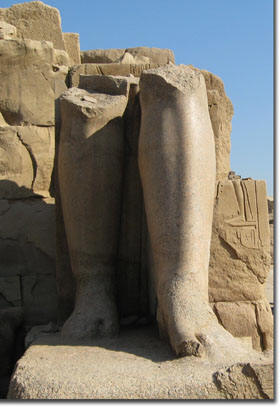
“I met a traveler from an antique land, who said, ‘Two vast and trunkless legs of stone…’.” Thus wrote the poet Shelley, back in 1817, when he wrote Ozymandius after visiting Egypt. For me, this was one of the lures that intrigued me about this visit, even though I was hesitant to make the journey, after all my travels of the last year. But our friends and travel companions were correct, so I’ll be up front and say, “Diana, you were right!”
This was the start of an amazing, wonderful, and awesome trip.
We left Chicago right on schedule on Alitalia. The flight was
smooth, the plane not very crowded, and we were well fed and plied with plenty of
red wine. I managed to get a couple of hours of sleep, but a very
annoying crying baby kept waking me up. But all in all, it was a good
flight into Milan. This was much better than my last experience
with American based airlines. The departure from Milan was delayed
about 20 minutes, but we did the three hour flight to Cairo pretty much
on time. So we are here. Egypt has a population of about 80
million, and 18-20 million people live here in Cairo. Compare
Chicago, with 9.7 million, or Los Angeles, with 13 million).
plane not very crowded, and we were well fed and plied with plenty of
red wine. I managed to get a couple of hours of sleep, but a very
annoying crying baby kept waking me up. But all in all, it was a good
flight into Milan. This was much better than my last experience
with American based airlines. The departure from Milan was delayed
about 20 minutes, but we did the three hour flight to Cairo pretty much
on time. So we are here. Egypt has a population of about 80
million, and 18-20 million people live here in Cairo. Compare
Chicago, with 9.7 million, or Los Angeles, with 13 million).
 Cairo
is crowded, sprawling, and – as expected – a mixture of ancient and new.
The traffic was horrendous, as was expected, with everyone fighting for
their slice of the road. There appear to be no traffic signals and
everyone just kind of drives where they feel like. Of surprise,
was that driving is on the right, and not the left, as I would have
expected from the British days.
Cairo
is crowded, sprawling, and – as expected – a mixture of ancient and new.
The traffic was horrendous, as was expected, with everyone fighting for
their slice of the road. There appear to be no traffic signals and
everyone just kind of drives where they feel like. Of surprise,
was that driving is on the right, and not the left, as I would have
expected from the British days.
Barb and Diana were just fascinated with the unfinished construction.
It seems that the taxation structure applies less tax if a building is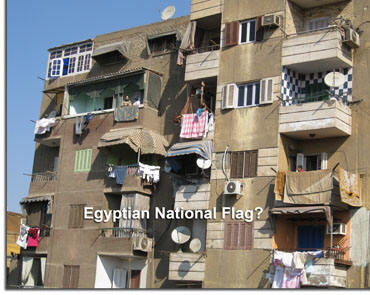 unfinished. No occupancy permits here!. Many of the
buildings have vertical supports with extended rebar. And
practically all apartments have laundry hanging outside the windows.
The lines seem to be built right into the building walls. We were
told it is the Egyptian national flag.
unfinished. No occupancy permits here!. Many of the
buildings have vertical supports with extended rebar. And
practically all apartments have laundry hanging outside the windows.
The lines seem to be built right into the building walls. We were
told it is the Egyptian national flag.
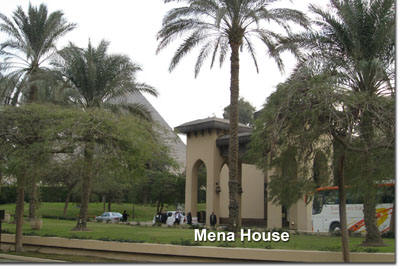 We
are in the Mena House Hotel, right in the shade of the pyramids.
The place is old, and rather famous, serving as a gathering spot for
world leaders and diplomats for the last 100+ years. We are all
fairly jetlagged, and will head down to dinner here in the hotel.
I’m going to get real tired of two weeks of bottled water.
We
are in the Mena House Hotel, right in the shade of the pyramids.
The place is old, and rather famous, serving as a gathering spot for
world leaders and diplomats for the last 100+ years. We are all
fairly jetlagged, and will head down to dinner here in the hotel.
I’m going to get real tired of two weeks of bottled water.

It is worth it all to have the thrill of seeing the lighted Pyramid of Cheops, right outside our window.

What are my first impressions? A visitor will see a mixture of old and new. Guys riding camels, women driving cars and talking on cell phones, donkey carts, hole-in-the-wall shops, high rise apartments, old and new mosques, loads of people.
January 15
Today we have to ourselves, as the tour kicks off with arrivals today. So we booked a short tour to take us around to some of the spots that we will miss and the tourists don’t normally see. We slept surprisingly well, awaking at 6:30 to the alarm. After a hearty breakfast, we met with our guide, Amr and our driver, Mohammed.

First we headed into downtown Cairo to the first of what I am sure will
be many mosques. First stop was the Mosque of ar-Rifai, which was
founded in 1819 and is a relatively new mosque. It’s distinction
is that it contains the bodies of not only King Farouk and his father,
but the body of Reza Pahlavi, last Shah of Iran. 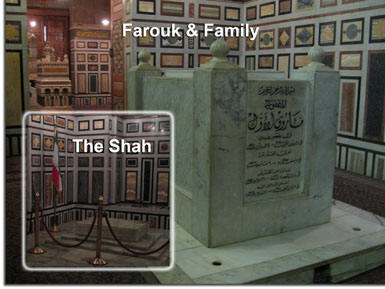 Seems he and Nasser were friends, and the latter allowed the burial,
when no one else wanted the body.
Seems he and Nasser were friends, and the latter allowed the burial,
when no one else wanted the body.
 The
mosque next door was the Sultan Hassan Mosque, built in 1356-61.
It was funded by estates of people who had died in the Black Death.
This increased the unpopularity of the Sultan, and before the project
was completed, he was murdered.
The
mosque next door was the Sultan Hassan Mosque, built in 1356-61.
It was funded by estates of people who had died in the Black Death.
This increased the unpopularity of the Sultan, and before the project
was completed, he was murdered.
Then it was on to the Mosque of ibn Tulun, which was built between 876
and 879
AD. It is walled and on high ground, and has the only exterior
spiral minaret outside of Iraq.
879
AD. It is walled and on high ground, and has the only exterior
spiral minaret outside of Iraq.
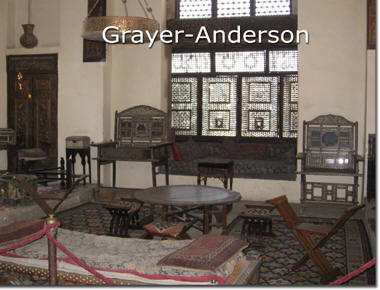 Adjoining
it is the home (actually two connected houses) used by John
Grayer-Anderson, who was the doctor to King Farouk in the 1930’s.
It has been preserved as a state museum housing his collections and
paintings. The home was actually comprised of two houses, one
built in the 16th century by a successful butcher, and rebuilt by
Grayer-Anderson. It was interesting to see how the men and women
lived
Adjoining
it is the home (actually two connected houses) used by John
Grayer-Anderson, who was the doctor to King Farouk in the 1930’s.
It has been preserved as a state museum housing his collections and
paintings. The home was actually comprised of two houses, one
built in the 16th century by a successful butcher, and rebuilt by
Grayer-Anderson. It was interesting to see how the men and women
lived separately.
separately.

From that point we headed to the Nile and lunch. John and I took a
short walk through the surrounding neighborhood, passing old and new,
small shops and throngs of people. We also stopped for a shot of
the central cemetery, The City of the Dead, which houses some twenty
million burial sites, as well as a fairly substantial squatter
population of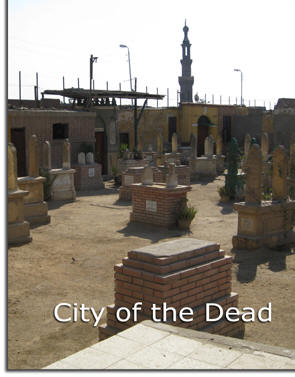 homeless (reports up to 1 million). Then we got the souvenir
shopping out of the way, and purchased a few baubles to take home as a
memory. Tomorrow President Bush is supposed to be here, so we are
starting early for the pyramids.
homeless (reports up to 1 million). Then we got the souvenir
shopping out of the way, and purchased a few baubles to take home as a
memory. Tomorrow President Bush is supposed to be here, so we are
starting early for the pyramids.
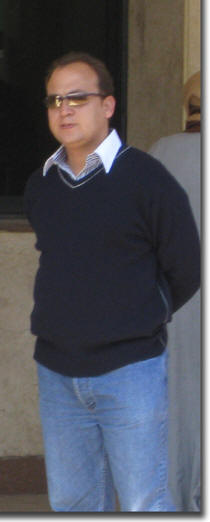
Let me introduce you to our guide. He is Amr Atef, and is 36 years old. He has been married for a year, his wife works for Vodaphone, and they live in Giza, a near Cairo suburb. Amr freelances his tour services, and has been doing so for 14 years. He has a master’s degree in Egyptology from the American University. Amr’s mother is a doctor, and his father headed up the private school system in Egypt. He is smart, funny, and a very companionable person. He would prove to be a huge asset in the coming weeks.
January 16
After a lousy nights sleep, we were out at 0800. It turns out that on this tour there are four people. Yes, that is correct. IT is just the four of us. So it is a very private tour.
The first place we visited was Memphis, the ancient capitol of Egypt.
It was originally established by King Menes (Narmer) who united upper and lower
Egypt. There we found the fallen statue of Ramses II, as well as
several sarcophagus, statues, and a small sphinx. Ramses II lies
as he was found, broken off around the knees,
originally established by King Menes (Narmer) who united upper and lower
Egypt. There we found the fallen statue of Ramses II, as well as
several sarcophagus, statues, and a small sphinx. Ramses II lies
as he was found, broken off around the knees,
 and
now covered from the weather. And of course, the ever present
vendors and sellers of fine merchandise.
and
now covered from the weather. And of course, the ever present
vendors and sellers of fine merchandise.
Ramses II ruled from 67 years and died at the ripe old age of 94. He had five or six wives and sired some 100 children. All in all, I'd say he was quite a busy man!. Therefore, there are many, many temples build for and by him.
From there, we traveled back toward Saqqara, passing lots of small plot agriculture, sheep herders, produce stands, and general life along the irrigation canal.

In Saqqara, we stopped first at the tomb of a vizier, or high official,
in this case, one Ka-Gmni, from around 2340 BC. The wall friezes,
were really astonishing, with their detail, and relief’s of daily life.
To think that this has lasted for these thousands of years really is
 amazing.
amazing.
 This was also the location for one of the first attempts at pyramid
building, the Step Pyramid of King Zoser (Djoser). It is six
levels of limestone, and is part of a large necropolis in the area.
This was also the location for one of the first attempts at pyramid
building, the Step Pyramid of King Zoser (Djoser). It is six
levels of limestone, and is part of a large necropolis in the area.
After lunch, it was back to Giza, and the famous three large pyramids. These are the largest of the nearly 128 pyramids found throughout Egypt. The largest, the Pyramid of Cheops, is comprised of approximately 2.3 million stone blocks, brought in from a quarry some 21 miles distant. Each block weights in at around 2.5 tons.
 The
structures were built by laying down a layer of block, and then building
earthen ramps which basically raised the ground level. Then the
stones were smoothed, a layer of water was poured over the stones, and
the next layer was added, stepping to the top. This, in effect,
vacuum locked the stones to each other. All the while, the
surrounding ground was raised as the pyramid grew. Once the top
was reached, the ground was excavated, and the surface of the structure
was plastered with a thick layer of limestone mortar, thus giving a
smooth appearance. Due to erosion and earthquakes over the
centuries, most of the mortar has disappeared, now being found only
close to the top of the second structure.
The
structures were built by laying down a layer of block, and then building
earthen ramps which basically raised the ground level. Then the
stones were smoothed, a layer of water was poured over the stones, and
the next layer was added, stepping to the top. This, in effect,
vacuum locked the stones to each other. All the while, the
surrounding ground was raised as the pyramid grew. Once the top
was reached, the ground was excavated, and the surface of the structure
was plastered with a thick layer of limestone mortar, thus giving a
smooth appearance. Due to erosion and earthquakes over the
centuries, most of the mortar has disappeared, now being found only
close to the top of the second structure.
There are three major pyramids – Khufu (Cheops), Khafra, and MenKaura, are tombs for father, son, and grandson. There is all sorts of mystical stuff about these – the fact that they are located in one of a few places on earth which is a space launching point, that if they were built in the time reported, a block would have to have been laid every 4 minutes, etc.
John and I went down into the burial chamber of the Khafra tomb, which
was difficult, in that it was narrow, required considerable bending and
forced one to put aside the fact that there was about a billion tons of
stone over your head once you were in it. It was also quite warm
inside. I did it, but don’t have to repeat the journey. Once there, you see an empty chamber, with a
plain stone sarcophagus.
repeat the journey. Once there, you see an empty chamber, with a
plain stone sarcophagus.
The archeologists also discovered a complete, disassembled wooden boat buried next to the pyramid. One of several located near the pyramids, this one has been reassembled and put on display as the “Solar Boat.” It is so named because it carried the pharaoh, like the sun, across the sky. Some of the original rigging and matting was also on display.
 John
and I did the obligatory camel ride, and then the final stop of the
afternoon, the Great Sphinx. As these are the most popular
exhibits in the area, there were a lot of people. But Amr said
that it was not really very crowded. He said in high season, it is
just crazy.
John
and I did the obligatory camel ride, and then the final stop of the
afternoon, the Great Sphinx. As these are the most popular
exhibits in the area, there were a lot of people. But Amr said
that it was not really very crowded. He said in high season, it is
just crazy.
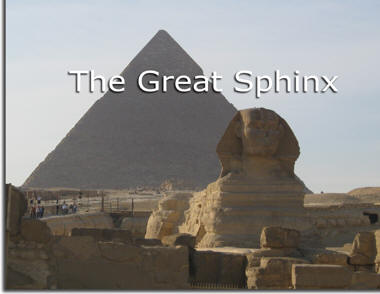
The Sphinx has the usual enigmatic smile, and was created as a guard for the pyramid area. The nose was chipped off - was was the case in many statues and reliefs, because the Egyptians believed that the soul entered and exited the body through the nose. Thus enemies would break off the nose to keep the spirit trapped inside.
Then back to the hotel for a much needed nap. Tonight is the sound and light show at the pyramids.
Later. Anyone who said that Egypt is hot this time of year clearly had not been here at night. I rented blankets for the show, and we still were just about ten seconds from freezing. Man, it was cold as only a desert can get at night. The light show was pretty nice, and reiterated much of what we had learned of the pharaohs Ramses, King Tut, Hatshepshut and Nefertiti. We returned through the now lighted – a much more interesting – neighborhood shops to the hotel, a well deserved glass of wine, and bed.
January 17
 We
deviated from the planned tour schedule and did things out of order.
So instead of first heading to the Museum of Antiquities, we went to Old
Cairo and visited several Christian (Coptic) churches. Egypt at
one time had a large Christian population. The first visit was to
the Hanging Church from the 4th century. It is so named
because it was built on the foundation of a Roman
We
deviated from the planned tour schedule and did things out of order.
So instead of first heading to the Museum of Antiquities, we went to Old
Cairo and visited several Christian (Coptic) churches. Egypt at
one time had a large Christian population. The first visit was to
the Hanging Church from the 4th century. It is so named
because it was built on the foundation of a Roman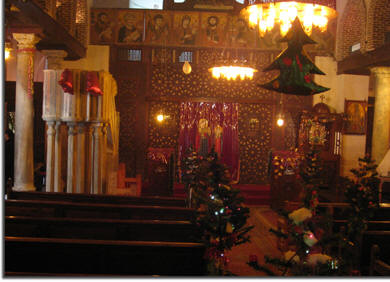 watchtower, and thus is about two stories above the general ground
level. It had restored mosaics along the entryway. While
waiting for the church to open, we hit the Church of St. Serge’s, which
is reputed to have sheltered the Holy Family in it’s crypt during their
flight to Egypt. It dates back to the 5th century, AD.
From there it was off to the church of St. Barbara with it’s collection
watchtower, and thus is about two stories above the general ground
level. It had restored mosaics along the entryway. While
waiting for the church to open, we hit the Church of St. Serge’s, which
is reputed to have sheltered the Holy Family in it’s crypt during their
flight to Egypt. It dates back to the 5th century, AD.
From there it was off to the church of St. Barbara with it’s collection
 of
carved 13th century relic icons. The Christmas displays
are up because the Coptic New Year and holidays are celebrated in early
January, instead of the western holiday period.
of
carved 13th century relic icons. The Christmas displays
are up because the Coptic New Year and holidays are celebrated in early
January, instead of the western holiday period.
We next visited the Ben Ezra Synagogue, which is where Moses was supposedly found. Built in the 8th century, it is now more of a tourist center than a practicing church. Originally, there was a large Jewish population in Egypt, but that has dwindled to around 500 people in the last 20 years. Of the some 30 synagogues still in existence, there are only two in active operation.

Then we were off to the Citadel, which was built by Sal ah Din (Saladin) for his victorious battle against the Crusaders. Within, is a large mosque, that of Mohammed Ali. The Citadel covers about 14 acres and interestingly, contained only soldiers. The families lived outside the walls. Built in a high ridge, right across from the stone quarries, it offered a nice view of downtown Cairo.
Next was the market at Khan el Khalili. A definite tourist trap,
but fun none the less. Barb was not real impressed, as the place
is a rabbit warren of passages, shops, lots of tourist junk, and people
all trying to take your money. In fact, one young enterprising
young
 man
was direct and asked, “Sir, how may I take your money?” Give him
credit for honesty! We did get sort of off the beaten track, much
to my delight and Barb’s dismay. However, there are plenty of
armed guards about, and there are so many people, that any trouble would
be instantly quashed.
man
was direct and asked, “Sir, how may I take your money?” Give him
credit for honesty! We did get sort of off the beaten track, much
to my delight and Barb’s dismay. However, there are plenty of
armed guards about, and there are so many people, that any trouble would
be instantly quashed.
After lunch, it was off to the Museum of Antiquities, which was less crowded. There we saw all the King Tut materials – jewelry, masks, coffins, viscera jars, - everything that was been seen of TV and in the publications. There were some beautiful items, but I can’t show pictures as no photos were allowed. As expected, there were the usual collection of statures, found objects, and items from the ancient Egyptian periods. Also on display were the mummies of Ramses (a physically big man in life as well as death), Nefertari, and other nobles. Frankly, it all looked a tad tired, but history museums do have a tendency to present themselves in that manner.
 Then
back to the hotel. After four days, my impressions are: the
traffic is chaotic and heavy, the crowds are dense, the people are
friendly, there are lots of armed police around, and there is a definite
mixture of old and new, as evidenced by the new cars, mixed with burro
carts, the scarf and chador clad women next to women in designer jeans
and heels. It’s an interesting place. Breakfast is often at
10 or 11, lunch (the big meal) at 4, and dinner at 10 or 11.
Needless to say, things open late in the morning and stay open late at
night. Prayers are called at sunrise, Noon, 3 PM, sunset, and
evening. Tomorrow we are out of here for the south.
Then
back to the hotel. After four days, my impressions are: the
traffic is chaotic and heavy, the crowds are dense, the people are
friendly, there are lots of armed police around, and there is a definite
mixture of old and new, as evidenced by the new cars, mixed with burro
carts, the scarf and chador clad women next to women in designer jeans
and heels. It’s an interesting place. Breakfast is often at
10 or 11, lunch (the big meal) at 4, and dinner at 10 or 11.
Needless to say, things open late in the morning and stay open late at
night. Prayers are called at sunrise, Noon, 3 PM, sunset, and
evening. Tomorrow we are out of here for the south.
January 18
As requested, we were up and out by 0230. Actually, we felt better than expected, a condition for which we will suffer later in the day. But for the moment, all is well. It is really amazing how alive Cairo is at 3 AM. Clubs are open, flower shops are open, just everything is alive and vibrant. There wasn’t much traffic, so we made it to the domestic airport in record time. First, a brief word about traffic. Lanes are optional, the traffic lights are sort of a suggestion, like many countries, headlights are optional, and to get through an intersection, you just nose your way in and get going. It sounds pretty chaotic, but once you understand it, I think it would be OK. Most cars do show battle scars in the form of bumper dings and side scrapes. It is quite a contest, fought by cars, trucks, carts, and motorcycles. People do yield for necessary things, as I expect the paperwork for an accident is ferocious. Enough on that.
 We
hopped an Egypt Air flight to Abu Simbel, arriving around 7:30 AM.
A short bus trip took us to the temple of Ramses II, which was literally
surgically carved from its original location and moved some 130 feel up
and 200 feet away from the rising waters of Lake Nasser, which was
formed when the Aswan dam was built in the 1970s. This was quite
an engineering feat. Done by UNESCO, the temple was literally sawn
apart, marked, and reassembled in the new location. But the
engineers were not infallible. The original location was designed
to light the interior
We
hopped an Egypt Air flight to Abu Simbel, arriving around 7:30 AM.
A short bus trip took us to the temple of Ramses II, which was literally
surgically carved from its original location and moved some 130 feel up
and 200 feet away from the rising waters of Lake Nasser, which was
formed when the Aswan dam was built in the 1970s. This was quite
an engineering feat. Done by UNESCO, the temple was literally sawn
apart, marked, and reassembled in the new location. But the
engineers were not infallible. The original location was designed
to light the interior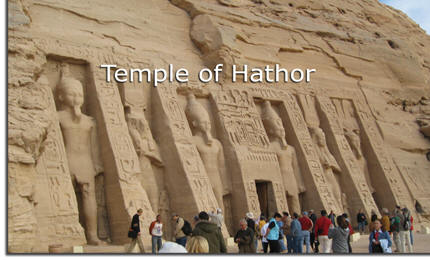 statuary on two days – Oct 21, and April 21, to commemorate Ramses
birthday and his ascension to the throne. The modern engineers
missed the positioning by one day (one degree)! The interior
relief’s and paintings are well preserved and astounding, considering
that they have been around for some 3,000 years. Also at this site
is the Temple of Hathor, which was built by Ramses II to honor his
favorite wife, Nefertari. We then did some bartering for tour
books, are sure we got taken (big surprise), but the fun was in the
negotiating.
statuary on two days – Oct 21, and April 21, to commemorate Ramses
birthday and his ascension to the throne. The modern engineers
missed the positioning by one day (one degree)! The interior
relief’s and paintings are well preserved and astounding, considering
that they have been around for some 3,000 years. Also at this site
is the Temple of Hathor, which was built by Ramses II to honor his
favorite wife, Nefertari. We then did some bartering for tour
books, are sure we got taken (big surprise), but the fun was in the
negotiating.
Leaving Abu Simbel, we hopped back on Air Egypt for the short flight north to Aswan. First stop on the bus was at the Aswan High Dam. Built by the Russians in the 1970s, it is visually not very impressive, as most of the workings are underground. It is some 980 meters thick at the base, and provides 40% of Egypt’s total electricity needs. It has some backup from the original dam, built by the British.
 Our
hotel is the Cataract Hotel, originally built in 1890. It is a
charming place, with an old interior cage elevator, high ceilings, and
lots of history. Agatha Christie wrote her “Death on the Nile”
book here, and famous persons from the world over have made this a stop.
It was very relaxing to sit on the veranda, have a glass of wine, and
watch the sun drop below the horizon, as feluccas passed on the river.
The Aga Khan’s
Our
hotel is the Cataract Hotel, originally built in 1890. It is a
charming place, with an old interior cage elevator, high ceilings, and
lots of history. Agatha Christie wrote her “Death on the Nile”
book here, and famous persons from the world over have made this a stop.
It was very relaxing to sit on the veranda, have a glass of wine, and
watch the sun drop below the horizon, as feluccas passed on the river.
The Aga Khan’s mausoleum is on a hill across the river, and the evening lighting makes
this a rather magical spot. The experience was further enhanced by
an excellent dinner in the 1902 Restaurant, which seemed a step back in
time to the early 20th century. As usual, though, the
better the hotel, the shorter the stay, and tomorrow we go to the river
boat. This is pretty nice, having Amr here as a guide. We
don’t have to do anything but relax and enjoy the sights.
mausoleum is on a hill across the river, and the evening lighting makes
this a rather magical spot. The experience was further enhanced by
an excellent dinner in the 1902 Restaurant, which seemed a step back in
time to the early 20th century. As usual, though, the
better the hotel, the shorter the stay, and tomorrow we go to the river
boat. This is pretty nice, having Amr here as a guide. We
don’t have to do anything but relax and enjoy the sights.
January 19
 After
a very pleasant breakfast at the hotel, we checked out and headed for
the Temple of Philae. This was actually a Greco-Roman temple.
When the Romans built these, they modeled them after the original style
Egyptian temples, so there are plenty of bias relief’s of the Egyptian
(Roman) gods. Some of the hieroglyphics are purely decorative and
there is graffiti from the ages – Napoleon, early visitors, even
defacing by early Christians (Coptics) left there mark. Which is
sad, because this was all pretty interesting? The temple is also
something of an engineering feat. It was about 80% submerged by
the first Nile dam, and the whole thing was carefully exposed by
installing a surrounding coffer dam. The structures were cut
apart, and reassembled on a higher island some short distance away.
After
a very pleasant breakfast at the hotel, we checked out and headed for
the Temple of Philae. This was actually a Greco-Roman temple.
When the Romans built these, they modeled them after the original style
Egyptian temples, so there are plenty of bias relief’s of the Egyptian
(Roman) gods. Some of the hieroglyphics are purely decorative and
there is graffiti from the ages – Napoleon, early visitors, even
defacing by early Christians (Coptics) left there mark. Which is
sad, because this was all pretty interesting? The temple is also
something of an engineering feat. It was about 80% submerged by
the first Nile dam, and the whole thing was carefully exposed by
installing a surrounding coffer dam. The structures were cut
apart, and reassembled on a higher island some short distance away.
After our visit, John and I were forced into purchasing gallabyas for
the
 upcoming
event on the ship. And then we stopped at the Papyrus Institute,
where we checked off the box for many souvenirs. The making of the
substance was all pretty familiar (take the core of the plant, pound it,
soak it, flatten, weave, press and dry) and we succumbed to the lure of
small paintings for our “Wall of Travel.” Our sales guy was a
young man, who was just finishing his doctorate and hoped to travel in
Britain and America on completion. He was only one example of the
friendly and courteous people that we have met on this trip.
upcoming
event on the ship. And then we stopped at the Papyrus Institute,
where we checked off the box for many souvenirs. The making of the
substance was all pretty familiar (take the core of the plant, pound it,
soak it, flatten, weave, press and dry) and we succumbed to the lure of
small paintings for our “Wall of Travel.” Our sales guy was a
young man, who was just finishing his doctorate and hoped to travel in
Britain and America on completion. He was only one example of the
friendly and courteous people that we have met on this trip.
Then it was off to the Aswan quarries, where we saw the “unfinished
obelisk.”  It seems that the rage at one time was to make these single piece
granite obelisks. The stone would be cut down from the side,
undercut, and then broken from its base, while it lay on its side.
Well, it was a bad day at the quarry when this one cracked. So it
remains, partially shaped, where it lay. Future obelisks were not
as tall as this, this eliminating to some degree the stress problems.
It seems that the rage at one time was to make these single piece
granite obelisks. The stone would be cut down from the side,
undercut, and then broken from its base, while it lay on its side.
Well, it was a bad day at the quarry when this one cracked. So it
remains, partially shaped, where it lay. Future obelisks were not
as tall as this, this eliminating to some degree the stress problems.
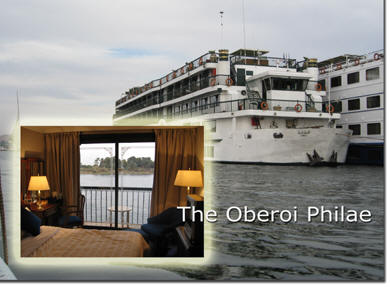
From there, on to the Oberoi Philae, our floating cruise boat home of the next four days. Our outside cabin has a balcony, but it has been so cold that I suspect we will barely use it.
We took a boat ride to the Kitchener Botanical Gardens, which were built by Kitchner as an experimental station for
tropical plant of all varieties, not just Egyptian. It was
pleasant to walk amidst the foliage of the tropical garden. And
then it was time to head back to the boat.
Gardens, which were built by Kitchner as an experimental station for
tropical plant of all varieties, not just Egyptian. It was
pleasant to walk amidst the foliage of the tropical garden. And
then it was time to head back to the boat.
 This
is very relaxing, watching the feluccas with their unique shelaa
triangular sails ply the Nile, seemingly just as they have done for
thousands of years. And in the near distance, you can see the
endless miles of the Sahara Desert, stretching far, far away to the
Atlantic Ocean. The skyline is only marred by the tower of a
hotel, which was obviously built by the Russians, which is slightly
This
is very relaxing, watching the feluccas with their unique shelaa
triangular sails ply the Nile, seemingly just as they have done for
thousands of years. And in the near distance, you can see the
endless miles of the Sahara Desert, stretching far, far away to the
Atlantic Ocean. The skyline is only marred by the tower of a
hotel, which was obviously built by the Russians, which is slightly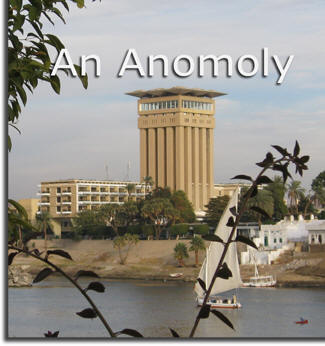 reminiscent of the Russian Embassy in Havana, Cuba. It is so
totally out of place that it really stands out.
reminiscent of the Russian Embassy in Havana, Cuba. It is so
totally out of place that it really stands out.
Later. We were greeted by the ship’s crew at the pre-cruise
cocktail party. So far, there are only about 40 people on the
whole ship. Amr has said all along that this is the slow season,
and that certainly appears to be the case. We seem to be the only
American’s, which was a subject for discussion at dinner. Everyone
we told about this trip asked, Why do you want to go there?” That was
only reinforced by our shuttle companions a week ago we went to Chicago.
They immediately asked the same thing! But so far, this has been
wonderful.
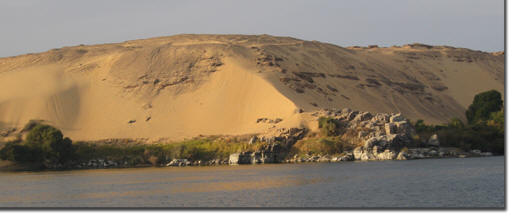 Standing
on the upper deck, watching street life pass by, and seeing the moon
shine on the Nile, is really a wonderful experience. The ship is
outstanding, with well appointed rooms, lovely dining and bar areas,
even a fitness center (which I should probably use!). We are all
tired, and the plan tomorrow morning is to do – nothing! I can get
into that.
Standing
on the upper deck, watching street life pass by, and seeing the moon
shine on the Nile, is really a wonderful experience. The ship is
outstanding, with well appointed rooms, lovely dining and bar areas,
even a fitness center (which I should probably use!). We are all
tired, and the plan tomorrow morning is to do – nothing! I can get
into that.
January 20
This morning dawned to start a rather slow day. We got up late, lounged around all morning connecting to the internet, read the paper, and generally spent a listless, relaxing morning. We all spent some time watching the street life of Aswan pass by the boat, and after lunch, we set sail. Barb figured that there are 51 people on the ship (capacity a little over a 100), so it is not crowded.
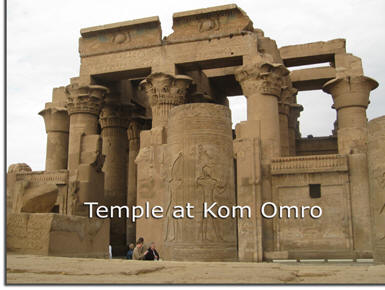 Mid
afternoon, we docked at Kom Omro, where we visited another Greco-Roman
temple. This one was pretty much in ruins, as the builders for one
reason or another (my contention is to cut labor costs) did not smooth
the stones and instead used wood tendons to hold the pieces together.
This technique did not have the lasting effect desired. There were
some well preserved
Mid
afternoon, we docked at Kom Omro, where we visited another Greco-Roman
temple. This one was pretty much in ruins, as the builders for one
reason or another (my contention is to cut labor costs) did not smooth
the stones and instead used wood tendons to hold the pieces together.
This technique did not have the lasting effect desired. There were
some well preserved
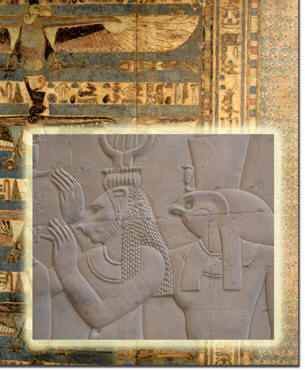 wall
reliefs, though, that commemorated the Egyptian skill in medicine.
And some of the original coloring remained on sheltered stones.
Bear in mind that the surface was carved plaster, applied after the
structures were built, and wet carved. This one was from around
200 BC, when the Romans were in the area, after Alexander died and
Ptolemy took over Egyptian rule.
wall
reliefs, though, that commemorated the Egyptian skill in medicine.
And some of the original coloring remained on sheltered stones.
Bear in mind that the surface was carved plaster, applied after the
structures were built, and wet carved. This one was from around
200 BC, when the Romans were in the area, after Alexander died and
Ptolemy took over Egyptian rule.
One thing of interest was a deep well, which is called a Nile-o-meter.
This was a basis for taxation in this time. The level of the Nile in the chamber would theoretically
determine how much silt was deposited during the flood season, thus
applying a standard for taxation. Amr said that was one of the
reasons that Egypt converted from Christian (Coptic) rule to Islamic,
was the latter promised no taxes.
time. The level of the Nile in the chamber would theoretically
determine how much silt was deposited during the flood season, thus
applying a standard for taxation. Amr said that was one of the
reasons that Egypt converted from Christian (Coptic) rule to Islamic,
was the latter promised no taxes.

We are now sailing to Edfu, where we will dock for the evening. Tonight is the gallabya party, so we all have to play dress-up. I’ll have pictures. I’m sure the Egyptians laugh. We all looked simply stunning in our get-ups. The bartenders fixed our scarves into headbands, which improved the look. But by 9:30, we were all beat, and turned in. It’s difficult having fun.
January 21
This morning was a bit overcast and dreary. In fact, it rained just a little bit while we were out, and we heard that it had rained at both Luxor (our next stop) and at Kom Omro (our previous port).
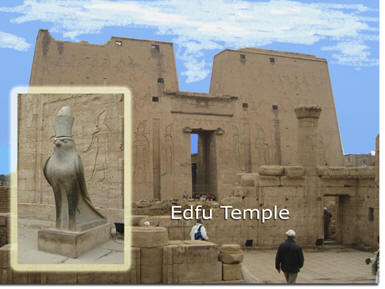 We
disembarked and visited the Temple of Edfu. This was a temple
built by the Ptolemy’s, to honor Horace, and his triumph over Seth, his
evil uncle. Keeping all the gods straight is a chore, and I need
the scorecard which we purchased. But we have learned enough to
identify some of the major ones.
We
disembarked and visited the Temple of Edfu. This was a temple
built by the Ptolemy’s, to honor Horace, and his triumph over Seth, his
evil uncle. Keeping all the gods straight is a chore, and I need
the scorecard which we purchased. But we have learned enough to
identify some of the major ones.
The Edfu temple was built between 300 BC and 200 AD, and was buried in
the sand until the late 1700s. It offers very nice relief’s of the
gods, the mythology, and is pretty much an intact structure. As
with most of these places, the figures are defaced, which is really a
shame, as this was some astounding artwork, and glimpse into life as it
was two thousand years ago. The place was crowded, but we did get
some pictures of Horace and some of the wall artwork.
Interestingly, some of the wall art is just that – wall art.
 It’s
there for decoration only. Also, if a cartouche is blank, it means
that the priests and workers were waiting for an Egyptian king to come
and carve in his mark. There is some color remaining, but frankly,
I thought that the Kom Omro Temple had more detail. This one wins
in size.
It’s
there for decoration only. Also, if a cartouche is blank, it means
that the priests and workers were waiting for an Egyptian king to come
and carve in his mark. There is some color remaining, but frankly,
I thought that the Kom Omro Temple had more detail. This one wins
in size.
 We
did a brief stop in the market so that I could take a few pictures.
There are plenty of horse drawn carriages, and donkey carts, hauling all
sorts of produce, from vegetables, the meat carcasses.
We
did a brief stop in the market so that I could take a few pictures.
There are plenty of horse drawn carriages, and donkey carts, hauling all
sorts of produce, from vegetables, the meat carcasses.
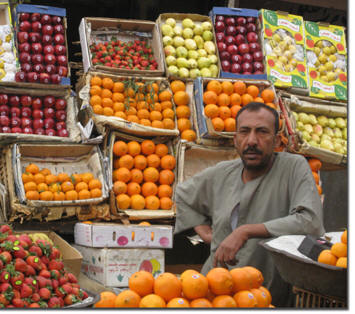 Then
it was back to the boat and we sailed for Luxor, our final stop.
After lunch, Amr gave us an update on the more recent history of Egypt.
Please note that there will be some errors here, but I’ll do the best I
can.
Then
it was back to the boat and we sailed for Luxor, our final stop.
After lunch, Amr gave us an update on the more recent history of Egypt.
Please note that there will be some errors here, but I’ll do the best I
can.

Modern Egyptian history really started around 1805. Egypt was a semi-autonomous region of the Ottoman Empire and was occupied in 1798 by the French, under Napoleon Bonaparte. The Empire sent Muhammad Ali to oppose the French. Ali backed a local, one Pasha Korsid, and managed to take over the country as ruler. He was enlightened to the point that he sent women to school and had education exchange programs with Europe. One of Ali’s friends from school was a Frenchman, Solomon, who converted to Islam. He took over the military side, and built a strong army and navy, with the latter’s ships being constructed in Italy. The European powers weren’t real thrilled with this, but he persisted. Ali went on to attack and beat the Ottoman Empire in 1827, and broke with the Turkish regime for good. The army also moved on the Sudan, and established a series of peace treaties with countries that bordered the Nile. These have lasted, though updated in 1954, to the present time. Ali also invaded Saudi Arabia, and put down the Wahbis.
 Once
Ali died, his son Said Pasha took over. He was sympathetic to the
agricultural industry, and so started the Golden Age of Egyptian
Agriculture. Said also had a French friend, who wanted to build
the Suez Canal. Though initially rebuffed, the French did
eventually build the canal, all 119 kilometers of it. The French
also built the flood and irrigation dams on the Nile as a part of the
deal. Over 150,000 Egyptian workers died building the canal,
either through over-work, or cholera. The Canal brings
in about six billion dollars into the Egyptian economy. First
opened in 1868, the construction is also to be thanked for the
construction of Mena House, the Cataract Hotel, and what is now the
Marriott Hotel along the Nile as lodging for the visiting dignitaries.
The operation was first owned by a multinational corporation, then by
the French, and then back to the corporation. Eventually Nasser
nationalized it, to obtain money for the construction of the Aswan dam.
There was some saber rattling over this by the European powers but in
1956, US President Eisenhower told them to back off. Relations
between the United States and Egypt have been good ever since.
Once
Ali died, his son Said Pasha took over. He was sympathetic to the
agricultural industry, and so started the Golden Age of Egyptian
Agriculture. Said also had a French friend, who wanted to build
the Suez Canal. Though initially rebuffed, the French did
eventually build the canal, all 119 kilometers of it. The French
also built the flood and irrigation dams on the Nile as a part of the
deal. Over 150,000 Egyptian workers died building the canal,
either through over-work, or cholera. The Canal brings
in about six billion dollars into the Egyptian economy. First
opened in 1868, the construction is also to be thanked for the
construction of Mena House, the Cataract Hotel, and what is now the
Marriott Hotel along the Nile as lodging for the visiting dignitaries.
The operation was first owned by a multinational corporation, then by
the French, and then back to the corporation. Eventually Nasser
nationalized it, to obtain money for the construction of the Aswan dam.
There was some saber rattling over this by the European powers but in
1956, US President Eisenhower told them to back off. Relations
between the United States and Egypt have been good ever since.

The assistant of the man who opened the canal, one Ishmael, borrowed a lot of money from the world community, to build an opera house, and to westernize Cairo. This started a long running dept situation with Egypt and the rest of the world. On the pretext of protecting their investment, in 1898, the British sent in some troops to Alexandria. In 1918, Orabi, an Egyptian military officer, wanted a raise for his troops of 5 pounds. He was denied, and unrest commenced, the King asked for additional British troops. So the ruling families wanted the British, the general population did not.
In 1936, King Farouk divorced his very popular wife, to take another. He started to squander the nation’s money on gambling trips to Europe. In the 1940s, there was general unrest, as things like education needs were not being met. A military group, headed by Nasser, backed a president Nagib, with Nasser eventually taking over all power for 16 years. Nasser wanted to build the new dam at Aswan, and when the United States and other western nations balked at loaning the money, Nasser turned to the Russians. This was still the Cold War, and the USSR obtained a foothold in Egypt. Nasser wanted to unite the Arab countries, and established the United Arab Republic. In doing so, he proposed to push communism on Syria, a trading nation, and one which is highly capitalistic. They balked, and the thing fell apart, although the League of Arab Nations still is an entity today.
 Nasser
remained popular, and in 1967 expelled a UN force from the Sinai
Peninsula. He closed the Straits of Tiran to all Israeli shipping.
Israel launched a pre-emptive strike to start the Six Day War.
When the dust settles, Israel held the Sinai, as well as the Golan
Heights. Nasser resigned, and Anwar Sadat took over. Sadat
booted the Russians and made major economic changes to the Egyptian
economy. There was some posturing over the Israeli occupation of
the Sinai, and in 1973, he attacked, meeting with initial success, but
was eventually defeated. A peace treaty was struck, and the Sinai
now is in Egyptian hands, although with only a token military force
present. In many ways this was a blessing, as the area is now a
hot tourist destination for Egypt.
Nasser
remained popular, and in 1967 expelled a UN force from the Sinai
Peninsula. He closed the Straits of Tiran to all Israeli shipping.
Israel launched a pre-emptive strike to start the Six Day War.
When the dust settles, Israel held the Sinai, as well as the Golan
Heights. Nasser resigned, and Anwar Sadat took over. Sadat
booted the Russians and made major economic changes to the Egyptian
economy. There was some posturing over the Israeli occupation of
the Sinai, and in 1973, he attacked, meeting with initial success, but
was eventually defeated. A peace treaty was struck, and the Sinai
now is in Egyptian hands, although with only a token military force
present. In many ways this was a blessing, as the area is now a
hot tourist destination for Egypt.
Sadat was assassinated in 1981, by an Iranian backed Islamic Extremist Group. Society sort of got tossed around a bit and Sadat was a friend of the Shah of Iran.
In 1981, Mubarek took over, and continues to rule to this day. It has been a struggle, but there is now about a 30% middle class, decent infrastructure (telephones, water, sewer, roads, schools, etc.). Medical care is subsidized on a two tier system. Education is compulsory, with one year of service for those that go to University, and three years for those that don’t. Mubarek has some opposition parties, but generally holds the reins of power. For a further, more complete, and factually correct relation of the history, go to http://en.wikipedia.org/wiki/History_of_modern_Egypt. Currently, the Egyptian economy stands at roughly 70 billion dollars. The primary driving force is agriculture, which brings in about 10 billion annually. It is followed by oil at 7 billion, the Suez Canal with 6 billion, and tourism coming in fourth at 6 billion.
January 22
 This
first thing this morning, we drove out of Luxor to the Valley of the
Kings. The east side of the Nile is considered the side of the
living, while the west side, the side of the dead. As to be
expected, the Valley of the Kings is on the west side. It is a
forbidding place, up above the Nile and hidden away from the lush
cropland of the river. This area is loaded with ancient tombs, and
to date, 62 have been discovered in the Valley of the Kings. Some
are quite deep, and virtually all of them had been robbed over the
centuries. The only exception is the tomb of Tutenkamon, which was
only discovered in the 1920s. Despite the fact that the graves
were empty, the wall carvings and colors were still very evident and
quite stunning to see. Unfortunately, there are no photos allowed.
We traipsed through three of them, Ramses the III, the IV and the IX,
with the
This
first thing this morning, we drove out of Luxor to the Valley of the
Kings. The east side of the Nile is considered the side of the
living, while the west side, the side of the dead. As to be
expected, the Valley of the Kings is on the west side. It is a
forbidding place, up above the Nile and hidden away from the lush
cropland of the river. This area is loaded with ancient tombs, and
to date, 62 have been discovered in the Valley of the Kings. Some
are quite deep, and virtually all of them had been robbed over the
centuries. The only exception is the tomb of Tutenkamon, which was
only discovered in the 1920s. Despite the fact that the graves
were empty, the wall carvings and colors were still very evident and
quite stunning to see. Unfortunately, there are no photos allowed.
We traipsed through three of them, Ramses the III, the IV and the IX,
with the
 addition
of King Tut’s, which was an extra charge. The interesting thing is
that Tut’s was quite small, yet the archeologists pulled 5,200 pieces
from the chambers. I can’t imagine how much was stolen and lost to
the ages from the other larger chambers.
addition
of King Tut’s, which was an extra charge. The interesting thing is
that Tut’s was quite small, yet the archeologists pulled 5,200 pieces
from the chambers. I can’t imagine how much was stolen and lost to
the ages from the other larger chambers.
Next visit was to the alabaster shop, with the obligatory demonstration
of how hand made
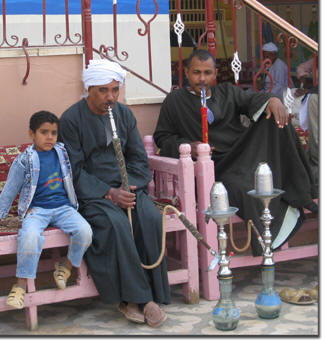 alabaster
jars, vases, and objects are carved, followed by the sales pitch to buy,
buy, buy. And sitting right outside, was a perfect scene of the
shisha, or hubbly-bubbly water pipe. Amr said the smoke is quite
strong.
alabaster
jars, vases, and objects are carved, followed by the sales pitch to buy,
buy, buy. And sitting right outside, was a perfect scene of the
shisha, or hubbly-bubbly water pipe. Amr said the smoke is quite
strong.
From there it was off to the Valley of the Queens, where there were more
chambers, and still more to be discovered. There were two young princes buried in this area, and
their tombs were much more decorated than the queens.
discovered. There were two young princes buried in this area, and
their tombs were much more decorated than the queens.
 Then
we were on to the Colossi of Memnon, the twin statues of Amenhotep III
guarding his mortuary temple which is in the process of being unearthed.
We drove past the monument to Queen Hatshepsut, which is impressive from
a distance, but has
Then
we were on to the Colossi of Memnon, the twin statues of Amenhotep III
guarding his mortuary temple which is in the process of being unearthed.
We drove past the monument to Queen Hatshepsut, which is impressive from
a distance, but has nothing inside.
nothing inside.
This was followed by Medinat Habu, the mortuary temple of Ramses III.
Many of these items had been buried in the sand for a long time, and the
color of
 the
areas were sunlight did not penetrate was remarkable. The Egyptian
government is intent on making this whole area an open air museum, and
is currently relocating the villages that were built on the land.
Interestingly, many of these homes were built over the mouths of ancient
tombs.
the
areas were sunlight did not penetrate was remarkable. The Egyptian
government is intent on making this whole area an open air museum, and
is currently relocating the villages that were built on the land.
Interestingly, many of these homes were built over the mouths of ancient
tombs.
As we drove along, we passed a lot of small shopping and agricultural
areas. I think Amr said that 80% of the population lives in 3% of
the total land mass, right here along the Nile. To me, there
seemed a great number of people just hanging around, sitting in cafes, and just not doing anything
productive. Perhaps this is good, but with a 12% unemployment
rate, such is the thing that trouble (and this in these militant Islamic
times) is made from.
hanging around, sitting in cafes, and just not doing anything
productive. Perhaps this is good, but with a 12% unemployment
rate, such is the thing that trouble (and this in these militant Islamic
times) is made from.
There is a heavy military presence, though. The Tourism and Antiquities Police are pretty much everywhere, and there are plenty of arms on the street. The Egyptians are quite sensitive to the tourist massacre some years back, and have taken great pains to eliminate a reoccurrence. Back at the shop, we walked into town for a bit, and then returned for tea, a very civilized custom. It is cold here. None of us packed for this weather, expecting temperatures at least in the upper 70’s. Au contraire! It is perhaps in the 50’s, and somewhat rainy.
January 23
 I
was up early, and just languished on the balcony for a bit, watching the
balloon rides rise from the west bank of the Nile. But it was time
to move out again. We were off the boat by 9 AM this morning, and
it was just as well, as the next load was getting on as we were getting
off.
I
was up early, and just languished on the balcony for a bit, watching the
balloon rides rise from the west bank of the Nile. But it was time
to move out again. We were off the boat by 9 AM this morning, and
it was just as well, as the next load was getting on as we were getting
off.

We first headed to the Temple of Karnak, which is the largest temple on
earth. The temple site comprises some 60 acres and also has the
longest colonnade in the world. Started in 1235 BC, it took
roughly a thousand years to build. There are many statues of
Ramses and the Egyptian Pharonic gods, obelisk and wall carvings and
inscriptions. The obelisk to Queen Hatshepsut is the tallest in
the world.
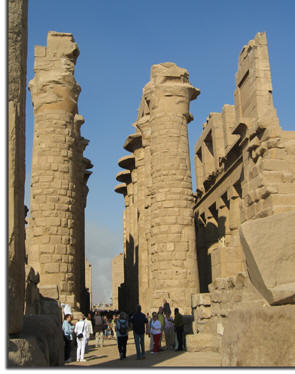 There
were lots of tour buses, but with such a large area, the place was not
very crowded.
There
were lots of tour buses, but with such a large area, the place was not
very crowded.

The temple complex faced to the west, and at right angles to it, facing north, was the Temple of Luxor. These two were connected by a three kilometer boulevard, completely flanked by stone statues of rams.
The Temple of Luxor is unique. It wasn’t discovered until the 1800s, and the site actually contains a mosque and
a Coptic church, all built at the existing ground level of the time,
right on top of the temple. So the mosque doorway is about three
stories off the current ground!. One chamber within the complex is
a temple built by Alexander the Great. One of the entrance
obelisks is missing and can be found in Paris at the Place de Concorde.
discovered until the 1800s, and the site actually contains a mosque and
a Coptic church, all built at the existing ground level of the time,
right on top of the temple. So the mosque doorway is about three
stories off the current ground!. One chamber within the complex is
a temple built by Alexander the Great. One of the entrance
obelisks is missing and can be found in Paris at the Place de Concorde.

Then we headed through downtown Luxor, where the locals shop, to the
train
 station
so that I could see the place and photograph a train.
station
so that I could see the place and photograph a train.
The engines and cars are Spanish, and look a bit tired. But wait, there was more!

On to the perfumery, where we were introduced to glass blowing, unique Egyptian perfume bottles, and scents to fill them. Is it touristy? Of course, but why not.
And finally off to our hotel for the evening, the Winter Palace.
The name is a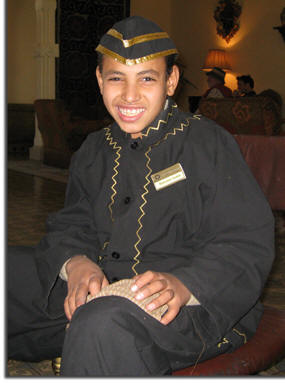 misnomer, as it was built as a hotel, and never an actual palace.
And of course, the old travel adage held true – “The nicer the hotel,
the shorter the stay.” I had my shoes shined by a kids who should
probably have been in school, and maybe was on a flexible basis.
So we are chilling out, and waiting for our 1915 pickup for the Karnak
Light Show. I think it will be cold again.
misnomer, as it was built as a hotel, and never an actual palace.
And of course, the old travel adage held true – “The nicer the hotel,
the shorter the stay.” I had my shoes shined by a kids who should
probably have been in school, and maybe was on a flexible basis.
So we are chilling out, and waiting for our 1915 pickup for the Karnak
Light Show. I think it will be cold again.
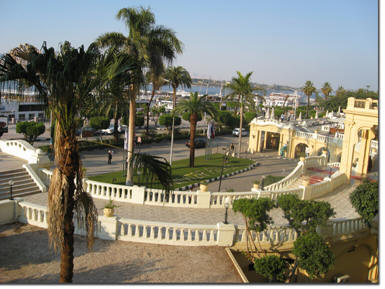 Amr
has left us, to briefly meet us again tomorrow afternoon. So we
are at the mercy of the local travel rep. Nicknamed “Baby Camel,”
our meeting is the one regret as I way under tipped him. I just
got my money mixed! I must say, that this trip, put together by
Big Five and the local provider, Travel Plus, has been astounding.
We have been pampered, coddled and extremely well taken care of.
Amr
has left us, to briefly meet us again tomorrow afternoon. So we
are at the mercy of the local travel rep. Nicknamed “Baby Camel,”
our meeting is the one regret as I way under tipped him. I just
got my money mixed! I must say, that this trip, put together by
Big Five and the local provider, Travel Plus, has been astounding.
We have been pampered, coddled and extremely well taken care of.
January 24
There really is not much to relate about today. We awakened to the sounds of the Muslim calls to prayer, and again watched the balloons soar across the Nile in the still morning air. Then it was off to the fairly modern Luxor airport for our hour return flight to Cairo. We were met in Cairo by Ahmed, who escorted us to lunch on a moored ship in the Nile. Then, it took us practically two hours to drive from downtown Cairo to our hotel. The traffic was practically in gridlock the entire way. I did mention driving before, and it hasn’t changed. It is still chaotic. The only slowing is for speed bumps. It is sort of a “Mr. Toad's Wild Ride.” Mohammed, our driver here in Cairo, was a professional, and I admire his work. One instance of note occurred today. He passed a container lorry (what we would call a semi-truck) on the right on a road under construction. He found his way further blocked by a police car. Mohammed cut between the truck and the cop, swung to the left around the cop into oncoming traffic, accelerated, and cut back in on the cop and further headed on down the road. It was quite a move! So the driving is fun to experience.
We are back at Mena House, and will have dinner, a short nap, and depart for the airport at 0100. It has been a lovely trip, and there isn’t anything about this experience that I would have changed.
January 25
After a two hour night, we were picked up on schedule at 0100 by our trusty driver Mohammed. We were escorted through the airport, and hopped on our Alitalia flight to Milan at 0405. The flight was a little faster than expected, so I only grabbed a two hour nap what with meal service. We killed a few hours in MXP, and then hopped onto the flight to Chicago. It appeared that the flight was not going to be full, so experienced flyer that I am, I staked out a center seat in the three seat center section about midway back in coach. And I was lucky. When the doors were locked, I owned three seats in the center section (seating on the 767 is 2-3-2). And Barb had two seats with a window. So after dinner, I was able to stretch out and nap for a couple of hours. It would have been longer if it hadn’t been for two obnoxious little kids. One was an Italian 4 year old, who just ran all over the plane, jumped on empty seats, and was a pain. The second was an American two year old girl, who screeched each time she didn’t get her way. Which was often. The mother’s were oblivious. The four year old got yelled at by the flight attendants, to no avail, and everyone sort of tolerated the two year old. So after a few naps, the film “The Jane Austin Book Club,” and multiple meals, we landed in Chicago right on time. It is a lot colder than we have been experiencing, but we got home in the late afternoon. Thus ended a really wonderful two weeks.
Addendum
 I
think that many Americans are afraid of visiting Egypt. It is,
after all, in the Middle East, an area we have all been lead to believe
– especially since 9/11 - is unsafe and unfriendly. Potential
travelers certainly shouldn’t be. Egypt is hospitable, safe,
beautiful and outgoing, with a warm and welcoming population. Yea,
it’s a long plane ride, and the language and signs can be intimidating.
But most people speak some English and they are more than willing to
help you out if you look lost. There is a large military presence,
so you see lots of AKs and H&K’s, as the country is very sensitive to
the Muslim extremists and what they can do to tourists,
I
think that many Americans are afraid of visiting Egypt. It is,
after all, in the Middle East, an area we have all been lead to believe
– especially since 9/11 - is unsafe and unfriendly. Potential
travelers certainly shouldn’t be. Egypt is hospitable, safe,
beautiful and outgoing, with a warm and welcoming population. Yea,
it’s a long plane ride, and the language and signs can be intimidating.
But most people speak some English and they are more than willing to
help you out if you look lost. There is a large military presence,
so you see lots of AKs and H&K’s, as the country is very sensitive to
the Muslim extremists and what they can do to tourists,
 and
subsequently, the fourth largest hard currency generator for the
economy.
and
subsequently, the fourth largest hard currency generator for the
economy.
The traveler gets to see some of the oldest wonders of the world.
And we are talking things that are five thousand years old, with
the original coloring and carvings. Five thousand years! It
is really impressive. Perhaps this trip was a bit too well
pampered, what with only four of us on the tour. But we were well
handled, our every need was met, and as I said, this was NOT the most
expensive tour. You do get a little tired of tipping, as everyone,
from vendors to washroom attendants, has their hand out for baksheesh.
out for baksheesh.
There are some things that we did not see, which would require a return visit. And I have just the guide to help you. Amr is well mannered, knowledgeable, with an exemplary reputation and is well known in the areas we visited. He knows the ins and outs and was flexible to change.
This visit was really special.
And Diana, “You were right!”